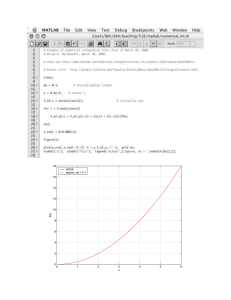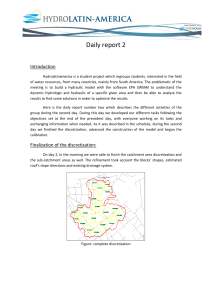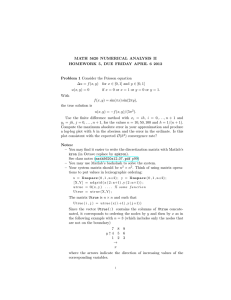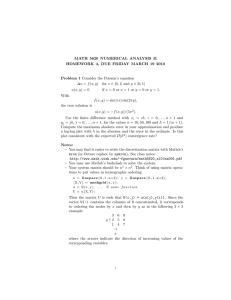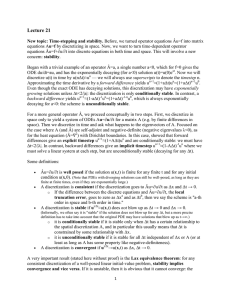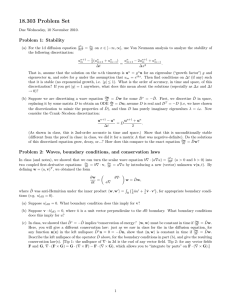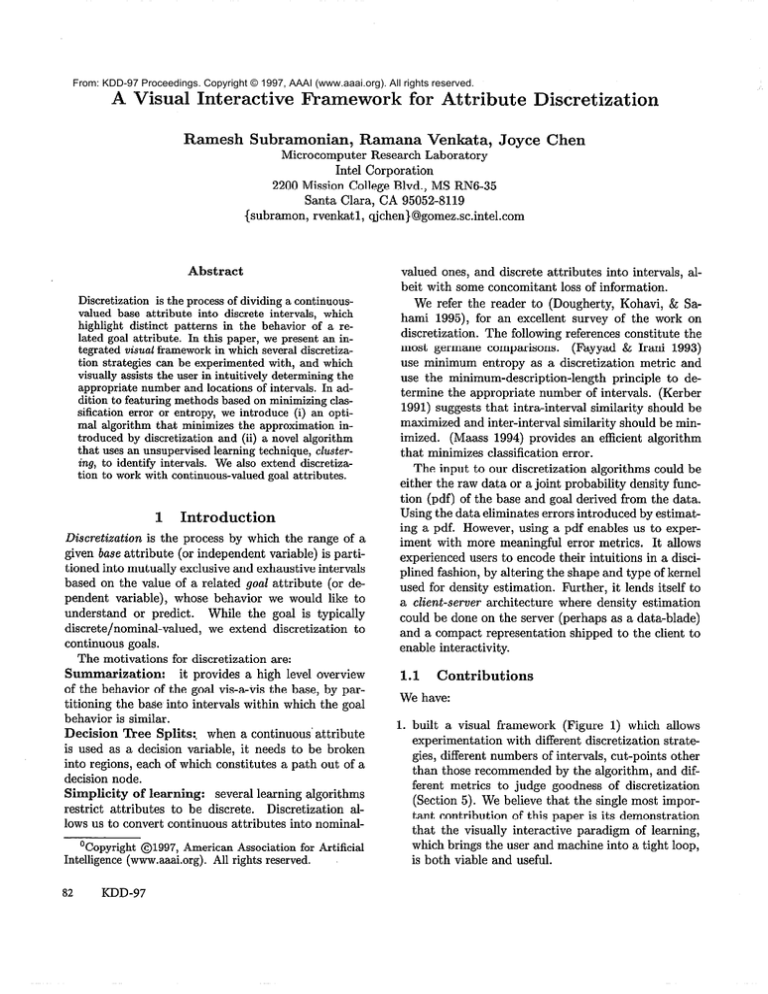
From: KDD-97 Proceedings. Copyright © 1997, AAAI (www.aaai.org). All rights reserved.
A Visual
Interactive
Ramesh
Framework
Subramonian,
for Attribute
Ramana
Venkata,
Discretization
Joyce Chen
Microcomputer Research Laboratory
Intel Corporation
2200 Mission College Blvd., MS RN6-35
Santa Clara, CA 95052-8119
{subramon, rvenkatl, qjchen}@gomez.sc.intel.com
Discretization is the process of dividing a continuousvalued base attribute into discrete intervals, which
highlight distinct patterns in the behavior of a related goal attribute. In this paper, we present an integrated visual framework in which several discretization strategies can be experimented with, and which
visually assists the user in intuitively determining the
appropriate number and locations of intervals. In addition to featuring methods based on minimizing classification error or entropy, we introduce (i) an optimal algorithm that minimizes the approximation in-
valued ones, and discrete attributes into intervals, albeit with some concomitant i0ss of information.
We refer the reader to (Dougherty, Kohavi, & Sahami 1995), for an excellent survey of the work on
discretization. The following references constitute the
most germane comparisons. (Fayyad & Irani 1993)
use minimum entropy as a discretization metric and
use the minimum-description-length principle to determine the appropriate number of intervals. (Kerber
1991) suggests that intra-interval similarity should be
maximized and inter-interval similarity should be min-
trodnced
imized,
Abstract
lp
discretimtinn
--L---2-_‘-.>---
ad
A-_
(ii\
\..,
a1 -_nnvd.-_ -~o-~‘
al!mrithm
L--
that uses an unsupervised learning technique, clustering, to identify intervals. We also extend discretization to work with continuous-valued goal attributes.
1
Discretization
Introduction
is the process by which the range of a
given baseattribute (or independent variable) is partitioned into mutually exclusive and exhaustive intervals
based on the value of a related goaE attribute (or de,r.,A#w,,
pcxrucxrll
.,nl:nhlr\\
"cumvlr;,,
..,hnnn
WIIVJG
Llthn.r:r,l.J~ua”I”I
. ..n
wr;
. . . . ..lA
W”UlU
l:l,,
IlILt?
cr.
b”
understand or predict. While the goal is typically
discrete/nominal-valued, we extend discretization to
continuous goals.
The motivations for discretization are:
Summarization:
it provides a high level overview
of the behavior of the goal vis-a-iris the base, by partitioning the base into intervals within which the goal
behavior is similar.
Decision Tree Splits:, when a continuous’attribute
is used as a decision variable, it needs to be broken
into regions, each of which constitutes a path out of a
decision node.
several learning algorithms
Simplicity
of learning:
restrict attributes to be discrete. Discretization allows us to convert continuous attributes
into nominal-
‘Copyright 01997, American Association for Artificial
Intelligence (www.aaai.org). All rights reserved.
82
KDD-97
(MRA.SS
1994)
,- --.-.-_
-L L -,
nrovider,
r-__--L
an
-__ efficient
_________ 1 kxwithm
1-o---L
_____
that minimizes classification error.
The input to our discretization algorithms could be
either the raw data or a joint probability density function (pdf) of the base and goal derived from the data.
Using the data eliminates errors introduced by estimating a pdf. However, using a pdf enables us to experiment with more meaningful error metrics. It allows
experienced users to encode their intuitions in a disciplined fashion, by altering the shape and type of kernel
used for density estimation. Further, it lends itself to
a ciient-server architecture where density estimation
could be done on the server (perhaps as a data-blade)
and a compact representation shipped to the client to
enable interactivity.
1.1
Contributions
We have:
1. built a visual framework (Figure 1) which allows
experimentation with different discretization stratem.:ncl
pxi,
rl:GL,n,+
uIIIczIrx1~
m.~ml.nro
IIUIIILI-ZLD
A:,+,,..,l,
“I lllbcil
“axi)
,-a..+ r\e:n+n
Lub-p”‘IIbJ
n&h,,,
“UICX
than those recommended by the algorithm, and different metrics to judge goodness of discretization
(Section 5). We believe that the single most important contribution
of this paper is its demonstration
that the visually interactive paradigm of learning,
which brings the user and machine into a tight loop,
is both viable and useful.
2. introduced a new discretization algorithm based on
clustering (Section 3).
set of mutually exclusive and exhaustive intervals, denoted as Z(C).
3. formalized the notion that discretization is a form of
approximation and provided an efficient algorithm
that captures this intuition (Section 2).
Problem
Definition
2.1 Given a pdfp evaluated at
a set of initial points Bo, a candidate set of cutpoints
CO, a desired number of cutpoints C, jind Copt E CO
such that (i) [C&l = C (ii) D~llq(Z(C,,t)))
is minimum.
4. provided a proof (by example) that the algorithm of
(Fayyad & Irani 1993) does not find the best multiinterval split whereas our algorithm does (Section 2).
5. extended discretization to work with continuous goal
attributes and demonstrated that doing so, rather
than imposing artificial categories on the goal, can
be advantageous (Section 4).
6. demonstrated that density estimation can be gainfully used for interactive discretization (Section 7).
2
Discretization
to minimize
difference
Intuition
The effect of discretization is to approximate the goal behavior as being the same over an entire
!-..-."A
ucmt:
:..J.r\..-ml
IllbCl
"al.
U,.,"?.
IltmLC)
.l:,.,....-.+:~,c:~,
UIDLl~blzxzbl"lI
ft"J..b","
J‘"‘bW‘"
&L,
Cllt:
:,:,c
J""Ib
pdf, PG,B, of the goal G and the base B, to a constant
value within each interval. This suggests that the best
discretization is that which minimized the approximation introduced.
Given p and a set of intervals Z = {Ii}, one
can define the approximation qG,B as follows: (i)
h, b2
E
Ii
*
qG,B(g,
bl)
=
qG,B(g,
62)
and (ii)
&I. c, PG,Bbr bldb = I&. c, qG,B[& b]db. Hence,
we &ant to find the set of iniervals that minimizes the
distance between p and q. To indicate its derivation
from Z, we write q as q(1).
Metrics used to measure the distance between the
two pdfs, p and q, are:
1. Kulback-Leibler
(KL)
distance
(Cover &
Thomas 1991) = D(pllq) = &p(z) log $$
2. L-1 norm D(Plld = s,cc, I PWI -cdgl~l I) P[Wb.
Our implementation offers minimization of Class
Entropy
(CIE) (Fayyad & Irani 1993)
as an option. CIE = - xi q(bi) Cj q(gjlbi) log(gjIbi)
where i spans the intervals, and j spans the values the
goal can assume. It can be shown that minimizing
KL-distance is equivalent to minimizing CIE.
Information
Problem
Statement
For
~m-mutational
r---ll--_-----.-
mn-noses.
r--r-LA,
we evaluate p at n values of B chosen so that the integral of the density between adjacent points is roughly
the same. Formally, let pG,B(g,b) be a pdf s.t. g E
{gi),b E Z?O= {bi) where bi E R,i < j + bi <
bj, l&l = n. Given Bo, define CO = { bi+ii+l }. With
any set of cutpoints, C, one can define an associated
Algorithm
SP We create a weighted, undirected
graph where the nodes are the candidate cutpoints,
Co, augmented by two distinguished vertices, a source
S and a destination D representing the left and right
extrema of the base. Each node i has a location Eoci
such that i < j + loci < Eocj. We create edges
= (i,j),i < j. The weight, wi,j of ei,j, is the
eij
distance between p and q over the interval spanned by
eij . Recall that this distance is D(pllq) conditioned
on b E [Zoci,Zocj]. Finding the optimal cutpoints is
equivalent to finding the shortest path from S to D of
a specified length, which is C + 1 in our case. This
is easily done by dynamic programming. Note that
i < k < j + ~ik + Wkj < Wij. This reflects our intuition that the more the number of cutpoints, the less
the discrepancy between p and q.
Theorem
2.1 Algorithm SP solves Problem
O(n”(C + 1)) time using O(n”) space.
2.1 in
Sketch:
The graph has O(n2) edges. Let
sp(i, j, 1) be the shortest path from i to j of length
1. Calculating sp(S, D, Ic) requires O(n) work to find
the minimum of sp(S, i, Ic - 1) + sp(i, D, 1). Maintaining sp(S, i, k) for all values of i requires O(n2) work for
each value of L. Creating a single edge weight could require as much as O(n) work, since it might span O(n)
intermediate nodes. However, earful organization and
re-use of computations and amortizing the cost over all
edges, allows us to compute all edge weights in O(n2)
work. To seewhy this is true, observe that sp(i+l, j, 1)
can be easily derived from sp(i, j, 1) by subtracting the
influence of sp(i,i + l,l). The “subtraction” process
requires O(1) work but is too detailed for presentation
q
here.
Proof
Sub-optimality
of greedy algorithms
(Fayyad &
Irani 1993)‘s algorithm to discretize based on minimizing Class Information Entropy (CIE) is greedy, in that
it y&u”.,’
~V-PEPVT~~PP
nuictintr
AU
I.,” V”
‘““‘LLt,
rhnirnc
nf rlrtnnintc
“LA”.UU” “I
YYYy”“.‘“”
rirhrm
waroh..ALVSI ““~I_“~-
ing for additional cutpoints. A simple example shows
that this is a sub-optimal strategy. Let the data initially fall into 4 intervals and let the goal have 2 classes.
Let ci,j be number of instances in interval Ii of class
j. Let cl,1 = 48,~~ = 16, c2,1 = 65,~~ = 53,
C3,1 = 43,c3,2
= 73, C4,l = 84,C4,2
= 70.
The best
Subramonian
83
one cutpoint is between intervals 1r/12. The best two
cutpoints are between intervals I2/I3 and Is/14 yielding CIE = 0.67117 . A greedy algorithm, forced to
retain its first cutpoint when looking for its second,
could not find the optimal two cutpoints. Setting cutpoints between intervals 11/Is and 1s/14 yields CIE =
0.67168. Setting cutpoints between intervals II/&J and
I2/I3
yields CIE = 0.67222.
3
Maximizing
adjacent
differences
Another approach to discretization is suggested by the
rationale that adjacent intervals ought to be as dissimilar as possible; else, they should not have been
separate intervals at all. Kerber (Kerber 1991) calls
the “defining characteristic of a good discretization”
as “intra-interval uniformity and inter-interval difference.” However, his Chimerge algorithm has the drawbacks that (a) it does not specify what objective function it is trying to optimize (b) the algorithm merges
small intervals to achieve large ones. However, for
small intervals, the x2-test, used to judge whether intervals ought to be merged, is imprecise.
Our approach uses ciustering to partition the space
(defined by the range of the base and goal attributes)
into classesso as to minimize intra-class differences and
maximize inter-class differences. We then project the
class descriptions down onto a single axis, the base, to
determine intervals. The advantage is that we leverage
the robustness of clustering algorithms. We use a variant of AutoClass, which has performed well in many
other domains (Cheeseman & Stutz 1996). We believe
that this is an intersting application of unsupervised
learning techniques for a supervised learning problem.
Our notion of clustering, explained below, hypothesizes that there exists a parametrized description of
the data generation process that needs to be discovered
by the clustering algorithm. The data is presented to
the clustering algorithm which aims to find the best
description. This typically involves a computationally
expensive search.
3.1
The
Finite
Mixture
Model
(FMM)
The FMM postulates that the data is generated in the
following fashion. Assume that the number of classes,
J, is known. First, class probabilities, pj are selected.
Assume attributes are independent. To each attribute
Ic of each class _i is assigned a functional form Fjik with
parameters {yj,,~+}(e.g., a Gaussian and corresponding
mean and standard deviation ,Uj,k,aj,h). Typically, the
choice of functional forms is restricted to a few simple
ones.
Instances are generated as follows. First select a
class: class j is selected with probability pj. The lath
a4
KDD-97
attribute of the instance is determined by drawing a
random variable from Fj,k and parameters {yj,h}.
3.2
Problem
Statement
Given the data, the number of classes, C + 1, and the
types of functional forms permissible, the first problem is to find the best parameters (whether Maximum Likelihood estimates or Maximum A Posteriori
estimates, if a Bayesian approach is preferred). Let
vj(b) = Fj(b : {Y~,B}) be the probability that a random variable B drawn from the distribution Fj,B with
parameters {T~,B} has values in [b, b + dbl. For example, N(z : ~,a) = &exp(-i(y)2)
Let q(b)
be the probability that an instance whose base value
~j vj (b)
Let
is b belongs to class j i.e., wj(b) =
Cjpjuj(b)’
K(b) = j’ s.t.
7”
wj(b) =
wjt(b).
Problem
Definition
3.1 Given C and a FMM, the
problem is to find a set of C + 1 mutually exclusive and
exhaustive intervals Z = {Ii} such that xl, x2 E li +
K(x1)=
TTTvve
K(x2).
---J
ueeu
L^ --^L-:^L
IJO L'es:LI-lcb
LL---L,-lJ11e pI-ulJlerrl
L..f--..
uelul-e
__-we
^^--I-...
ca11km1ve
it because:
1. the base attribute is continuous and needs to be discretized (else an infinity of conditions of the form
(Vx E Ii, K(x) = j’) will need to be verified). We
do so as in Section 2.
2. the projection of J classeson to a single axis does not
always yield J intervals. This is because it may not
be possible to satisfy the condition (Vx E li, K(s) =
j’) for certain FMMs. For example, consider two
equally weighted classes, one being N(0, 1) and the
other being a bimodal distribution, consisting of
N(-2,1) and N(+2,1). In this case, there exists
no partitioning of the real number line into 2 intervals such that the condition (Vx E Ii, K(x) = j’) can
be satisfied. Or one class may be subsumed by the
other classes i.e. 3jVxK(x) # j.
Problem
Definition
3.2 Given a FMM consisting
of J classes and a candidate set of cutpoints Co, find
the smallest set Copt c CO, (corresponding intervals
are I
= {Ii}), such that x1, x2 E Ii 3 K(xl) =
K&z).
Theorem
time.
3.1 Problem 3.5 can be solved in O(IColJ)
Sketch:
Classifying a cutpoint into one of J
classesusing a single attribute (the base) requires O(J)
work. We then make a single pass over the Cc cutpoints, from left to right, accumulating adjacent cutpoints with the same classification into an interval. 0
Proof
4
Continuous
goal attributes
Most existing work on discretization has been confined
to discrete goal attributes i.e., where each instance has
a nominal valued class attribute. A continuous valued
goal attribute would have to be discretized (e.g., return on investment could be mapped to {High, Low })
to fit into existing paradigms. We suggest that there
are situations where it is preferable not to coerce an
intrinsically continuous goal into discrete classes prior
to discretizing the base e.g., discretizing age based on
dollar value of insurance claims paid.
To test this hypothesis, we discretized a synthetic
data set created using the FMM (Section 3.1) with 2
attributes (attribute 1 is base and attribute 2 is goal)
and 3 classes (J = 3, K = 2) and parameters:
‘dj 13j= l/J, Qj’Vk uj,k = 1
111,l
=
-2,
P2,l
=
0, P3,l
=
2
/42,1
=
-2,
/J2,2
=
%P3,2
= 4
System
Description
We briefly describe some salient features of Id-Vis,
our interactive, visual data-mining tool. The GUI is
built using Tcl/Tk (Ousterhout 1994) and Tix (Lam
1996). Id-Vis currently runs under Windows NT* 4.0
on a 200 MHz. Pentium(R) Pro Processor.
Snm~
l.J”I.IU
nf thn
“L
“Al.., Gmr
‘,bJ tan&a
“~IIU””
nf
“L n,,r
“US
rlmirm
U”Ul~”
nhilnwmhv
y’A’~“““y’LJ
ITP.
US”.
Portals Users can interact with the system at their level of expertise and comfort. The
system provides the user with information and manipulation handles at the level of detail specified. For
example, the user can go so far as to alter the pdfs by
Multiple
Partitioning
The database resides
on, and operations thereupon take place on, the
of the
server, while an appropriate distillation
data is sent to the client, where all of the visual,
GUI-based operations are performed at interactive
speeds. When necessary during drill-down, requests
are made of the server for more narrowly-focused
data.
Client-Server
User-chosen values are always given
priority over system-derived values. The latter,
which are optimum by some metric, continue to be
available as fall-back options.
User Primacy
Immediate feedback is provided during user experimentation, in easy-to-read graphical
modes. Knowledge gained from this process is always available for immediate recall.
Interactivity
Discretizing the goal as Positive and Negative and
setting the number of intervals to be 2 yielded cutpoints of -2.174 and 0.157. However, without discretizing the goal, we got cut-points of -1.0012 and
1.0949. We believe that these cut-points correctly
capture the difference between the positive and more
positive instances which is washed out if the goal is
discretized. However, if the goal were discretized as
Negative (z < 0), Positive (0 < z < 2) and MorePositive (2 5 z), we get cut-points of -1.425 and 1.405.
While the algorithms of Sections 2 and 3 extend
naturally to continuous goals, extending the minimum
error discretizer is not as straight-forward. This is because it requires one to quantify the error associated
with an instance having a goal value of z when the
average goal value in the interval is y. In contrast,
measuring the error of classifying an instance as blue
when it is in fact red is simple. None of the error metrics we considered seemed quite right.
5
tweaking the kernel width used for the density estimation, or can let the system choose all parameters,
including the discretization type, and the number
and locations of the cut-points.
All object creation/display operations
are written in Tcl/Tk/Tix, while all speed-critical
operations are implemented in ANSI C.
Portability
Each analysis tool in Id-Vis presents the user with
a graphical interface containing a set of interactive
controls, display windows which project an immediate
feedback to the manipulation of these controls, and a
means to propagate the user-chosenvalues and parameters downstream.
Figure 1 shows the interface to the Discretizer tool.
The top pane contains the interactive controls for modifying the type of discretization, the type of badness
measure (seeSection 6 for definition) employed to evaluate the results, the number and locations of the cutpoints, and the loss functions associated with the various goal categories, for a discrete goal.
The bottom pane contains the display windows that
provide the feedback. In this pane, the top left window
displays the results of the discretization process, i.e.
the base discretized into intervals,‘each with similar
goal behavior. To start with, the system shows the
optimal (i.e. with the least badness value) locations
for the cut-points, for the Min. Classification Error
type of discretization and classification error as the
badness measure. Within each interval are shown the
relative proportions of the goal categories, weighted by
the loss functions. This display window is interactive,
and provides controls for the user to add, delete and
move the cut-point locations to satisfy specific user
constraints or curiosity. Also, using the controls in the
Subramonian
85
Figure 1: Id-l/is Discretizer Window
top pane, the user can experiment with other types
of discretization algorithms. The bottom left display
shows the locations of the valid cut-points for each type
of discretization that the user tries out.
The bottom right display shows the chosen badness
measure’s values, for the current number of cut-points,
over all discretization types. Blank fields indicate that
the computation is not yet performed. When the user
starts experimenting with the number and/or the locations of the cut-points, this window provides a feedback
on how the user-chosen values are performing relative
to the system-derived optima. This serves as an aid
to users in determining the extra cost involved in their
choice.
The central philosophy is that the system should
place the user within the appropriate context (e.g. in
the discretizer window, display system-derived number and locations of the cut-points) and provide the
user with the opportunity to intelligently modify (e.g.
display the impact on accuracy of these modifications)
86
KDD-97
these optima and propagate them downstream.
5.1
“To cut 9 or not to cut”
The top right display window in the Discretizer interface displays the behavior of the chosen badness measure, for the current type of discretization, as the number of cut-points increases. This is very useful to the
user in determining the number of cut-points that best
discretize the data. All of our discretization strategies
show a marked drop-off in the incremental reduction in
the badness measure, when the number of cut-points
is increased beyond that which is logical for the data.
It is visually apparent to the user in a compelling manner. We will discuss more about this in Section 7.
5.2 Client-Server
Interactions
When the server ships the data to the client (either
initially, or in response to a change in the discretization type etc.), it executes the following steps: 1. after
sorting the data by the base values, it streams this raw
data past a compactor which keeps track of the goal behavior and assembles large regions tagged with a summary description of the regional contents. e.g. region
3 has 150 instances of red-category goals, 20 of greencategory and 15 of blue-category. The explicit locations of these instances within a region are not tracked;
2. if the client needs the data in a non-pdf format (as
at the start), these regions, along with their tags, are
directly shipped to the client. Otherwise, the original data is streamed past a density-estimator,
which
generates a probability density function; 3. this pdf is
evaluated at uniformly spaced points (say, 20000) and
the results are sent to a distiller. It then re-evaluates
the pdf such that the integral of the density between
adjacent points (say, 1000) is equi-probable; 4. this
distilled pdf is finally shipped to the client.
As mentioned earlier, the top left display in the Discretizer window shows the relative proportions of the
goal categories within each interval. If more detailed
information is desired, the user can click on the Drill
Down button in the top pane. The client then asks
Figure 2: Drill Down Results
the user about the accuracy constraints on the request
If these can be met using the locally available data, the
. client generates the necessary population data. Else,
the drill-down request, along with the cut-point locations, is transmitted to the server. Depending on the
accuracy required, the server computes the population
figures within each interval either from the existing regions, or regenerates the regions appropriately. This
data is then displayed on the client desk-top in a popup window (Figure 2). In future versions, we intend
to furnish the user with the estimated costs of meeting
the various levels of accuracy, before the user makes
the choice.
We have experimented with several discretization
strategies, that differ both in the intuitions behind
them as well in their mathematical development. In
this section, we report on our experiments using these
strategies on different data sets.
Table 1: Cut-Point locations
The following is a brief description of the data-sets
upon which the experiments were performed. The
Auto-Mpg
(DSl)
(Merz & Murphy 1996) contains
398 instances concerning city-cycle fuel consumption,
with each instance describing 6 continuous and 2 discrete attributes. We pruned it to 385 to focus on
4/6/8-cylinder cars. The Synthetic
Data-set
1
(DS2) contains 1000 instances obtained from a pdf
consisting of two overlapping normals, with each instance describing a discrete goal over a continuous
Data-set
2 (DS3) contains
base. The Synthetic
5019 instances concerning the relation between the
l--_~ WI
-I ialLWIIIWWIIt!S
-..I----L!l-- WWIIWI
------J a.Ilcl
--a LL:------TJyypes
IJIlt:I?---:,-1a11111y
1IICUIIIBY.
Figure 3 shows, for the Auto-Mpg data-set, the behavior of the badnessmeasure (i.e., the approximation
introduced by partitioning the base range into intervals and assuming similar goal behavior throughout
each interval) as the number of cut-points increases.
For each type of discretization, only the correspondingly appropriate badness measure is shown, scaled
such that the zero cut-point value = 100%. Obviously,
the badness value decreasesas the number of intervals
allowed increases, reaching the zero value when the
number of intervals equals the number of instances in
the data-set. However, in practice, the desired number
of intervals (for decision-support etc.) is rarely more
than 6. For most data-sets, we can discern the logical
number of cut-points from this figure, as the number
when the incremental reduction in the badness (with
increase in the number of cut-points) sharply falls off.
Table 1 shows the cut-point locations, as returned
by each type of discretization for the three data-sets,
in each case for the logical number of cut-points.
Columns 3, 4, 5, 6 show the cut-points found by
using Classification Error CJZ, KL-distance KL, Lldistance Ll, Class Information Entropy CIE, and Maximum Likelihood Estimate EM. While DS.2 is best dis-?acretized with one cut-point (CPij, both DSi and- US3
are best discretized with two cut-points (CPl, CP2).
‘7
Discussion
Figure 3 shows quite clearly the rapid drop-off in the
badness-measurereduction, with increasing number of
Subramonian
87
DE: Auto-Mpg
8
CPs us Badness %
Conclusion
100
90
80
70
9
0
Work
1
2
3
4
5
6
7
8
References
Cheeseman, P., and Stutz, J. W. 1996. Bayesian
classification (autoclass): Theory and results. In et al,
U. M. F., ed., Advances in Knowledge Discovery and
Data Mining. AAAI Press/MIT Press.
Figure 3: Badness Measure Behavior
cut-points, beyond the number logical for the data. We
feel that this figure provides a very intuitive and convenient means of assessingthe number of cut-points that
best discretize the attribute. In all the cases tested,
both the CE and the CIE metrics show a dramatic
and very conclusive plateauing of their badness measures, beyond the appropriate number of cut-points.
The other measures also show a pronounced decrease
in the incremental reduction of the badness measure
beyond the appropriate number of cut-points.
All of the discretization strategies show substantive
a~raement
-o----- ____1 in
--_ the
1.--_ locations
-_--11-_-_L of the Cut-noints.
r --~~--- The
GE
and EM metrics return values that are in close agreement, both being based on the raw data. Note that
the cut-point locations returned by KL, Ll and CIE,
while being based on the pdfs with all of the concomitant benefits, are also close to the above values for all
practical purposes.
*
Discretization based on clustering EM often does not
return a vaiid set of cut-points for cut-point numbers
larger than this logical choice. For example, in the
Auto-Mpg case, this algorithm returns only up to 2
cut-points. So, unlike the other types of discretization,
this method doesn’t have a one-to-one correspondence
between the number of cut-points asked for and the
~.~~
-~I..~ -L...-----1
numr3er rwxrneu.
KDD-97
Acknowledgments
We would like to thank Richard Wirt, Dave Sprague,
Bob Dreyer and the Microcomputer Laboratory at Intel Corporation for providing support for this work.
Other trademarks are the property of their respective
owners.
# of CPS
88
and Future
We have created a novel framework for interactive discretization, which situates the user in an appropriate
context and then provides visual controls to modify
the knowledge gained and obtain graphical feedback of
the consequencesof doing so. We have incorporated
two novel algorithms and have extended discretization
to handle continuous goal attributes.
An important area for future work is the partitioning
of data and computation between the client and server
so as to enable visual interactivity without compromising scalability.
Cover, T., and Thomas, J. 1991. Elements of Information Theory. Wiley and Sons.
Dougherty, J.; Kohavi, R.; and Sahami, M. i995. Supervised and unsupervised discretization of continuOlJfjfp&_?rp,s.In prQgp&p<gsQf the 12th _T??gern,f?‘Q&
Conference on Machine Learning, 194-202.
Fayyad, U. M., and Irani, K. B. 1993. Multi-interval
discretization of continuous-valued attributes for classification learning. In Proceedings of the 14th International Joint Conference on Artificial Intelligence,
1022-1027.
Kerber, R. 1991. Chimerge: Discretizaion of numeric
7
attributes. In Proceedings of the 10th lVationa1 Conference on Artificial Intellgence, 123-128.
Lam, I. K. 1996. The Tix Programming Guide.
http://www.xpi.com.
Maass, W. 1994. Efficient agnostic pat-learning with
simple hypotheses. In Proceedings of the 7th Annual
ACM Conference on Computational
67-75.
Learning Theory,
Merz, C. J., and Murphy, P. 1996. UCI Repository
learning
databases.
?f
http://www.ics.uci.edu/mlearn/MLRepository.html.
Ousterhout, J. K. 1994. Tel and the Tk Too&it. Addison Wesley.

